The timing of when to water the potatoes for a good harvest
Planting potatoes in the ground is half the battle, then you should properly care for them. What is the timing of watering potatoes, how to do it correctly, what methods to use - every novice vegetable grower asks these questions. There is a dilemma between summer residents, some argue that the crop does not need to be watered, others prefer to moisten the plantings. How to be, everyone decides individually, and experts advise to water the beds with potatoes.
Do I need to water
It is necessary to water the potatoes. Plants take moisture from the soil during development. In the absence of natural precipitation, you need to water the culture yourself.
In addition to the green mass, potatoes form tubers. The peculiarities of their cultivation require timely watering. It should be carried out not only on time, but also to a certain extent. It is impossible to pour root crops, but they should not dry out either.
If the necessary conditions are created, the crop will yield the declared yield.
Signs of excess and lack of moisture
To properly grow tubers, you need to closely monitor their condition. In appearance, it is not difficult to determine the excess or lack of moisture. Watering potatoes is carried out after careful study of the appearance of the plants.
If the plant lacks water:
- leaves on the bushes droop and begin to turn yellow;
- stems do not grow, buds do not open;
- the smallest stems dry out.
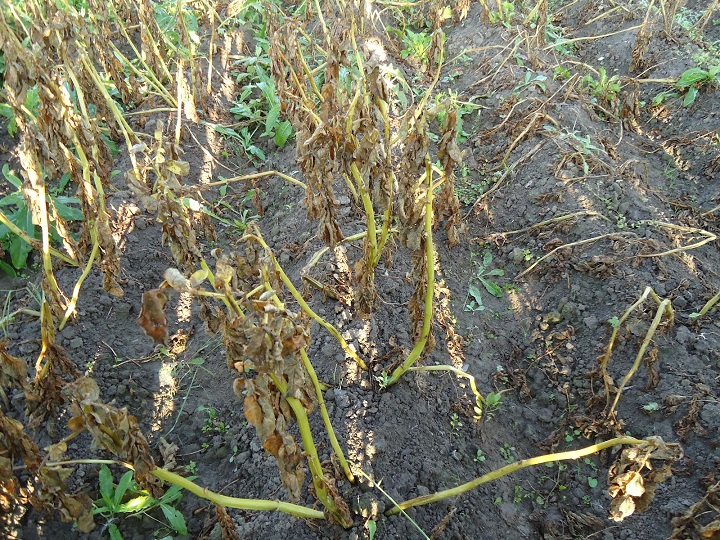
A lack or excess of moisture during the budding period leads to a loss of 20% of the yield.
When plants have excess water:
- the leaves droop, but their color is saturated, dark and the structure is watery;
- on the lower part of the stem, wet spots are formed, covered with a white or gray bloom;
- tubers begin to rot.
At low humidity, potatoes react poorly to fertilizing, since they do not reach the goal.
It is necessary to strictly monitor the appearance of plants in order to identify deviations in time. Receiving 4 liters of moisture, the plant grows and develops normally.
How best to water, all ways
The variety of methods for irrigating potatoes provides for the choice of a suitable method by summer residents. Everyone chooses the most convenient for himself and applies it on his site. For the root system, which develops during the entire growing season, a constant but measured application of moisture is necessary. In this case, the roots of the plant should receive no more than 4 liters of water. The methods are divided into 2 types: manual and mechanized.
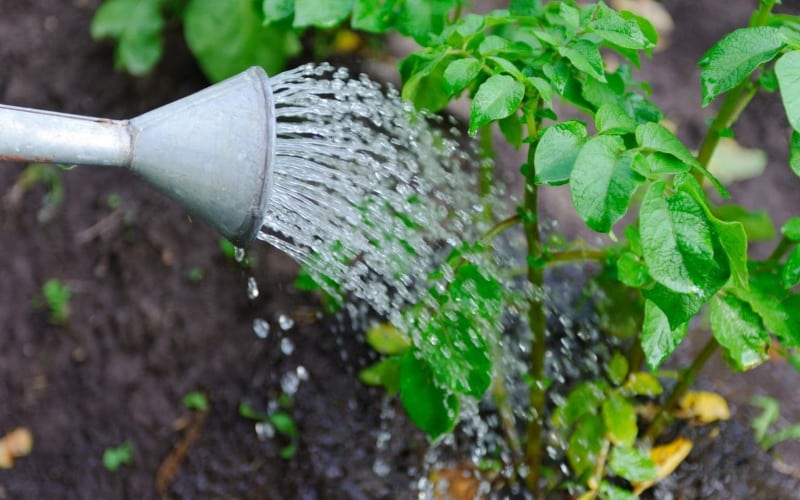
Watering by hand
For watering potatoes in the open field, this method is used if the plantings are small. Manual watering is carried out using hoses, watering cans, buckets and other improvised means.The summer resident will accurately calculate the rate, provided that all means are used for irrigation, except for the hose.
The advantages of this method are that water is poured directly under the roots. Thus, you will pour more accurately than with the mechanical method. And there is no need to fill the entire area. Water about 1 liter per 1 approach. Then repeat and make up to the required amount.
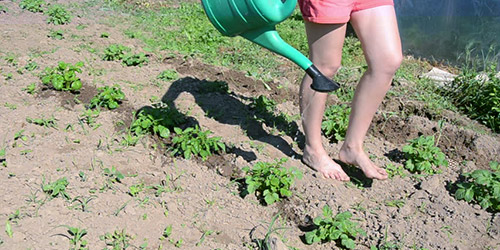
If you use an irrigation hose, it is better to have a nozzle, a spray. It does not erode the soil at the roots. Better to water one area, then move to the second, then return to the first again.
The disadvantage of the hose irrigation method is that it is impossible to determine the exact amount of water consumption per plant.
Not all summer residents have the opportunity to use this method, since it is difficult to carry buckets and watering cans. For convenience, a second type of irrigation methods has been created.
Mechanized watering
It is carried out with icy cold water or heated in the sun from special containers with the use of sprinklers.
They are classified into 2 types:
- drip;
- sprinkler.

Each has its own advantages and disadvantages. The downside to both mechanical irrigation structures is the high cost of installing and purchasing equipment. What methods of irrigation the summer resident will use, he decides for himself. Drip irrigation delivers water directly to the roots of plants, while the moisture does not evaporate and does not compact the soil. This is its advantage over sprinkler irrigators.
If you use sprinkler irrigation, you must choose the right droplet size.
Large drops strongly compact the soil, which is categorically unacceptable for planting with potatoes, and very small drops settle on the leaves and simply evaporate on them. Summer residents are touting the benefits of drip irrigation. Its plus is that you can water at any time. Drops do not fall on plants and do not cause burns.
"Dry watering"
If the weather is rainy, then potato plantings do not need irrigation with water, but loosening. In other words, dry watering. This method will help not only retain moisture for plants, but also provide oxygen access to the root system. Potatoes do not tolerate dense soil.

Mulching with various improvised materials - cut green manure, sawdust or weeds will help save moisture.
Watering rules
Watering potatoes should be done correctly. To do this, it is necessary to comply with the requirements and rules due to which the declared yield indicators are achieved.
- It is recommended to use warm water heated in the sun. Cold water reduces yields.
- Watering by mechanical irrigation using rain pans is carried out in the evening after sunset. This is to avoid sunburn on the leaves.
- The volume of water is from 3 liters for each plant and above. For proper irrigation, the irrigation rate depends on the composition of the soil, climate and rainfall.
- The culture requires more moisture during the budding period. For 1 plant, the water consumption rate is 5-6 liters.
- The first watering is carried out when the sprouts reach a size of 10 cm from the ground. Irrigation is not recommended for the reason that the mother tuber will start to rot and will not sprout.
- Early potato varieties are watered less than later ones.

To retain more moisture in the soil, the soil is loosened after watering..
When to water
The timing of watering potatoes depends on the accompanying factors. Therefore, it is difficult to answer this question in general terms. There is no need to rush to the first watering. Until sprouts appear that reach a size of 10-15 cm, it is generally not worth irrigating the land. The rate is 3 liters of water per plant in non-arid weather. Approximate time is 2 weeks after hatching.
As the plants grow, watered abundantly.If the summer is rainy, then 3-4 liters for each bush. Otherwise, 6-12 liters. In severe drought, watered 2 times a week.
If the summer is cool, then water it once every 10 days. Potatoes require special attention when they bloom. Then the number of irrigations and the volume of water are increased several times. The first flower appears as a signal to start watering. At this time, the culture begins to form tubers. Plantings continue to be abundantly irrigated throughout the entire period until the buds begin to fall off.
Watering the potatoes correctly is half the battle. A summer resident striving to get the most possible from planting a crop must comply with the rules, norms and terms of irrigation, while not forgetting about the standard agrotechnical methods of cultivation.
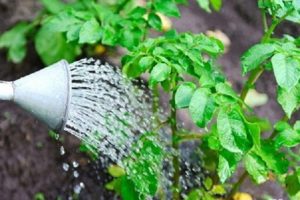
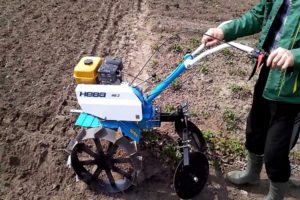
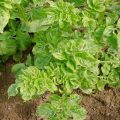
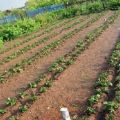
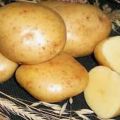
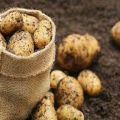




In order for the potato to grow well, you need to fertilize it, use growth activators, watering alone is not enough. As a growth activator I only use the product “BioGrow", recommend.
Watering is very important. It is better to follow the specified dates, then the harvest will definitely not disappoint you. Also, do not forget to fertilize the soil with bioactivators, I buy "BioGrow", He suits me completely.